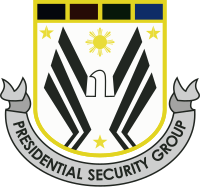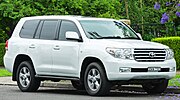|
Presidential Security Command
 The Presidential Security Command, (PSC)[1] formerly known as Presidential Security Group (PSG), is a Philippine close protection agency.[Note 1][2] It is the primary agency concerned with providing close-in security and escort to the President of the Philippines, their immediate families, former presidents of the Philippines as well as visiting heads of state. The PSC is stationed at Malacañang Palace, the official residence of the president. Members of the PSC also accompany the president on both domestic and overseas trips. HistoryWhile the present-day force was established in 1987, the protection of the president and the presidential family has always been the duty of the Armed Forces of the Philippines since 1897. On June 23, 1898, a guards unit called as the Cuerpo de la Guardia Presidencial (Presidential Guard Corps) was raised at the time to protect the first official president, Emilio Aguinaldo, from attempts on his life. Composed of a presidential cavalry squadron and artillery batteries, reinforced with multiple guards infantry battalions all under the command of Major Geronimo Gatmaitan, which provided the protection of President Aguinaldo and his family.[3] Like today's PSC, they wore rayadillo uniforms, but with straw hats. In 1936, the 1st Cavalry Regiment of the 1st Infantry Division, Philippine Army, raised the same year, was tasked with defending President Manuel Quezon, his family, and the palace complex. On May 22, 1938, they were joined by the Malacanang Guards, made up of a company organized into two to three platoons with a little over a hundred members, to reinforce the President's security. During the Second World War, the Presidential Guards were combined with the Philippine Constabulary and Manila ROTC units to form the new Second Regular Division which fought in Bataan. After the inauguration of the Second Philippine Republic, units of the occupying Imperial Japanese Army initially took over guard duties at the palace, only to be replaced by an all-Filipino guard battalion at the insistence of President José P. Laurel. During the Battle of Manila in 1945, Presidential Guardsmen remained at their posts in Malacañang. At war's end, it was in turn replaced by the AFP Presidential Guards Battalion under the orders of President Sergio Osmeña and would remain until the time of his successor, Manuel Roxas. The PSG of today traces its origins to 1950 when President Elpidio Quirino transferred the Presidential Guards Battalion under the control of the Philippine Constabulary (PC) in 1950.[4] At the same time, a separate presidential security unit was founded as the secret service and protective unit of the state presidency, the First Family, and Malacañang Palace, under the control of the Constabulary (first the Secret Service of Malacañang Palace then later renamed into the Presidential Security Force, the Presidential Security Unit, and then the Presidential Security Agency). On October 22, 1971, under the Presidency of Ferdinand Marcos, General Order No. 212 GHQ, AFP was issued, creating the Presidential Security Command (PSC) as a unified command of the AFP.[5] When President Corazon Aquino was sworn in as president, she gave the order to disband the PSC and replace with "a leaner" Presidential Security Group (PSG), with then-Army Colonel (and future Secretary of National Defense) Voltaire Gazmin as its chief.[6] This was formalized by General Order No. 60, GHQ-New Armed Forces of the Philippines (NAFP), which deactivated the PSC and activated the PSG as one of the support units of the NAFP.[5] The PSG, then as in the present, has always included both civilian agents and seconded servicemen from the Armed Forces. The PSG launched the PSG Troopers website on February 10, 2017, as part of an effort to improve public relations.[7] Information concerning the president's security arrangements are considered as classified.[7] Four PSG officers were wounded in an encounter with New People's Army guerillas in Arakan, North Cotabato after they were spotted running a fake vehicle checkpoint.[8] On September 26, 2017, a PSG officer was found dead inside the Malacañang complex with a gunshot wound to the chest.[9] In January 2024, the Department of National Defense officially disclosed that the Presidential Security Group (PSG) was expanded from a group to a command, now officially known again as the Presidential Security Command (PSC), restoring the setup of the organization during the time of President Ferdinand Marcos, late father and namesake of the current President, Bongbong Marcos.[1] The term PSC was earlier utilized on January 19 when the agency's Commander, MGen. Nelson Morales, issued a statement reacting to criticisms on Marcos’ use of the presidential helicopter to travel to the Philippine Arena in Bulacan to watch the Coldplay concert.[10] In 2024, the Armed Forces of the Philippines (AFP) activated the Vice Presidential Security and Protection Group (VPSPG), which is a separate unit from the PSG for the security of Sara Duterte. In July 2024, VPSPG will be totally integrated with the Presidential Security Command after 75 personnel of the Police Security and Protection Group (PSPG) assigned to the VPSPG were transferred to the National Capital Region Police Office.[11] RoleThe role of the PSC is tasked with:[12]
The Presidential Security Command also have other functions, such as providing support to other government agencies. They assist the AFP and PNP in its anti-organized-crime and corruption undertakings, usually authorized by the Office of the President. They also conduct community service efforts in local communities, and maintain and secure all facilities and transportation assets used by the offices of the president and vice president in doing its regular and non-regular functions.[13] OrganizationThe following are organized under the PSC (formerly the PSG) as of 2023:[14][15] Key personnel
Units
RecruitmentAgents are usually personnel from the Armed Forces of the Philippines, Philippine National Police and Philippine Coast Guard. However, there are a few civilian personnel acting as support units. Military and police personnel serving in the PSC retain the ranks and insignia of their parent service which are worn in almost all orders of dress. Equipment
PSC members are known to carry assorted firearms, some known firearms include: The PSC utilizes Motorola trunked two-way radios with encryption capability.[17] VehiclesThe PSC currently uses a fleet of vehicles, ranging from motorcycles; armored modified sedans and mid-sized vehicles; and armored personnel carriers.
NotesReferences
External linksWikimedia Commons has media related to Presidential Security Group. |
||||||||||||||||||||||||||||||||||||||||||||

![Glock pistols[16]](http://upload.wikimedia.org/wikipedia/commons/thumb/7/7b/GLOCK_17_Gen_4_Pistol_MOD_45160305.jpg/180px-GLOCK_17_Gen_4_Pistol_MOD_45160305.jpg)
























